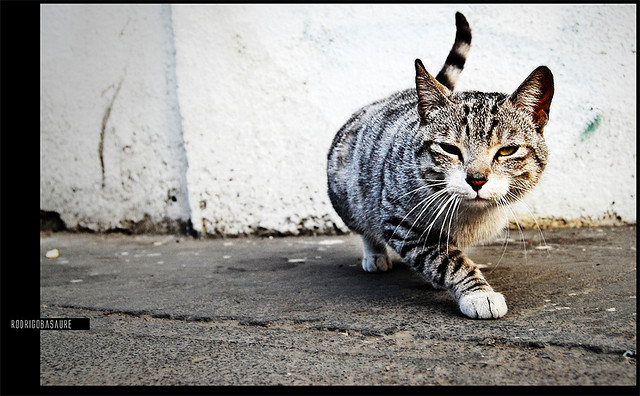
Today Janice Hardy published a terrific post about how to evoke emotion: How to Set Tone and Mood in Your Scenes.
Janice gives us two rules of thumb:
1. Avoid generic words
2. Show don't tell
Avoid generic words
Generic words, even though accurate, can fail to elicit emotion in your readers because they apply to any situation.
We want words that are specific because, in general, the more specific they are the less familiar they are. The unfamiliar makes us curious.
Show don't tell
Which of the following is more interesting?
a) The man walked through the dangerous courtyard.
b) The man, hands shaking, picked his way through the courtyard littered with unexploded mines.
Or even: "The novice, hands shaking ...." 'The novice' is more descriptive because it's less generic than 'the man.'
Bob's Dangerous Trek
Janice Hardy gives an example of how to transform a passage of lackluster prose into something that has the ability to reach out and emotionally move readers.
Example 1: Dull, unmoving, prose
Bob walked across the courtyard, nervously looking over his shoulder at every noise. He knew someone was back there, he could feel it in the twisting pit of his stomach.That's actually not bad. I don't think Janice Hardy can bring herself to write truly lackluster prose! But it's still a good example. We see that Bob is nervous but we're not feeling afraid for him, we're not on the edge of our seat, fingers digging into the armrests, holding our breath, afraid that something tragic is going to happen to Bob.
What's the problem?
Janice writes, "the word choices here tell more than they show, and they aren't very specific."
Example 2: Better but not best
Bob crept across the courtyard, glancing over his shoulder every few steps. Someone was back there. The twisting pit in his stomach was never wrong.Now Bob creeps instead of walks, he glances instead of "nervously looking." Also we're out of Bob's head. Instead of being told that Bob knew someone was back there, we're simply told someone is back there.
Example 3: The best
Bob slowed. Sunlight filled the courtyard ahead, chasing away the shadows and exposing every potential piece of cover. No way anyone could hide out there, but that applied to him as well as whoever was behind him. If anyone was. Crap.Much, much, better. Right?
Janice Hardy talks about the changes she made to produce this effect, as well as about the improvements that were made at each iteration of Bob's Dangerous Trek, but what struck me right off was that the improvements to Example 3 aren't just improvements in prose but also about improvements in storytelling.
In the third example we see through Bob's eyes in a way we didn't before.
- We see where he is about to travel (the sunlight filled courtyard).
- We see the danger (sunlight chased away the shadows exposing every potential piece of cover Bob could have used to conceal himself from his pursuer)
- We understand the implication (Bob is in danger from his pursuer)
- We know that Bob knows the danger and more-or-less how he feels about it: "Crap."
Janice Hardy sums it up
How you choose to describe something and what you have your point of view character notice sets the tone of the scene. Generic words that apply to any situation do little to create a mood. Common or clichéd words and imagery give the sense that readers have seen this before, so they know how it's likely to play out. Even if you do surprise them with what happens, odds are the anticipation of that surprise was lacking, so you miss out on the emotional punch.
The goal is to keep your readers guessing what's going to happen next so they won't be able to put down the book until they finish it.
Examples Of Books Readers Can't Put Down
In his latest post, Romance Me, Baby, Chuck Wendig asks his readers to recommend romance and erotica books. One of his commentators wrote that she and her friends read the first of J.R. Ward's Black Dagger Brotherhood series as a joke then got hooked. She confesses that when she bought Ward's latest release in the series she didn't sleep till she read the entire thing--in under 24 hours! Another commentator replied that she had done the same thing.
Both comments are on the first page of Chuck's post, I tried to link directly to them but couldn't.
I mention Ward's books here because I've read the first few of Ward's series and they do have the can't-put-it-down quality many writers strive for. Here is a link to the first few pages of the first book in the series, Dream Lover.
I mention Ward's series not because I want to turn you into a Black Dagger Brotherhood addict (though that wouldn't be a bad thing!) but because I think her writing is a great example of emotionally evocative prose.
And JR Ward's work is marvelous anecdotal evidence that evocative prose sells like hotcakes! Dark Lover was published September 6, 2005 by Penguin Publishing and the Kindle version, priced at over $10, is sitting at #902 in the paid Kindle store. That's better than most books do when they're first released!
Question: Have you ever been unable to put a book down until you finished it? I know sometimes we don't want to admit which books have had this effect on us, but I was like this when I read the first book in Laurell Hamilton's Anita Blake series, Guilty Pleasures.
Other articles you might like:
- How To Create And Maintain The Habit Of Writing- How To Not Write Crap
- Writing Scenes: Getting Up Close And Personal; Using Sensory Language
Photo credit: "habit | 1 july" by cloth.paper.string | sarah under Creative Commons Attribution 2.0.









